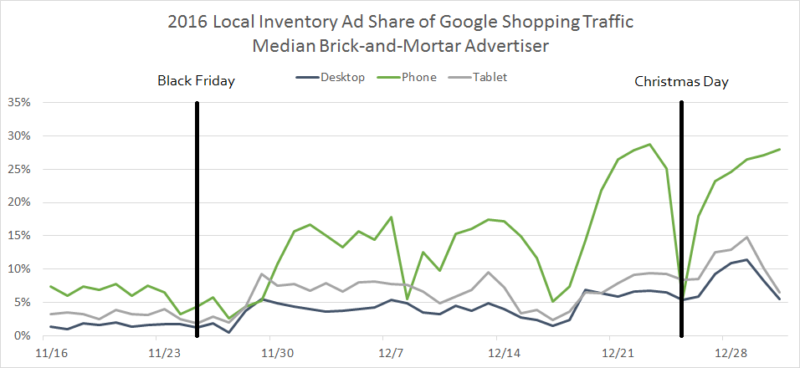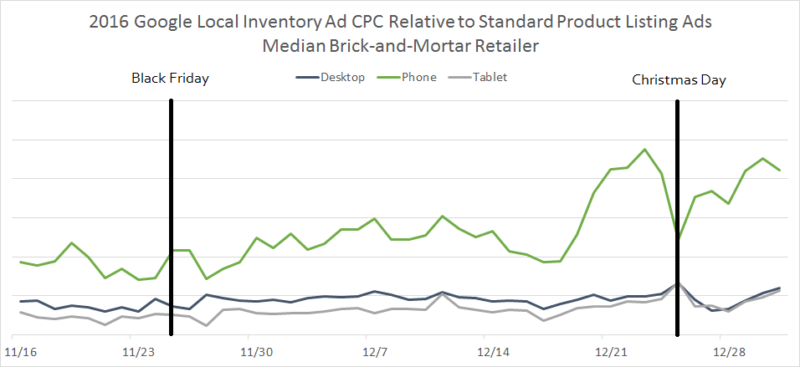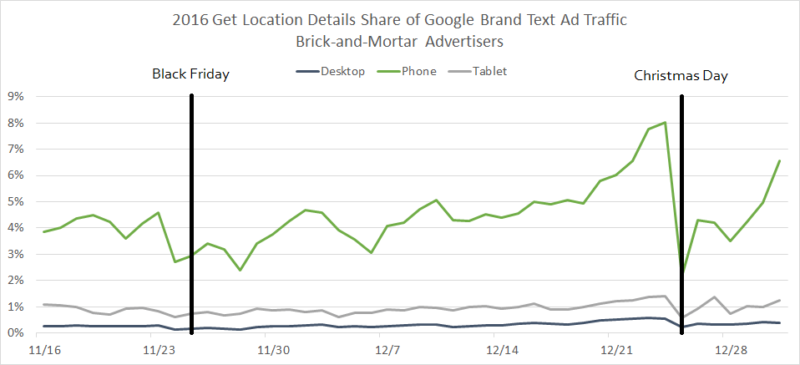Google locally focused ads poised to play important holiday season role for brick-and-mortar brands
If 2016 trends are any indication, search ads aimed at driving offline traffic are likely to have a big impact this year. Contributor Andy Taylor explains how to take advantage of the opportunities.
 Google has long touted the growth of queries with local intent, such as those that include the words “near me” or a location name, such as a city.
Google has long touted the growth of queries with local intent, such as those that include the words “near me” or a location name, such as a city.
Over the past couple of years, the search giant has set about to monetize this ever-growing segment of queries. Whether directly on its own domain, such as with Local Inventory Ads, or in its popular navigational app, Google Maps, new local formats are beginning to deliver meaningful shares of both brand and non-brand traffic.
It’s likely to have an even more dramatic impact this holiday season, as 2016 data showed strong growth of Local Inventory Ads and Google Maps ads leading up to Christmas Day.
Last-minute shoppers look to head in-store via Local Inventory Ads
Local Inventory Ads (LIAs) are a variation of Google Product Listing Ads that include local information about available products at certain retail locations. Retailers have increasingly adopted this format over the past couple of years, as Google has grown the prevalence of these ads for any queries that display local intent.
Looking at the share of all Google Shopping traffic attributed to LIAs for those brick-and-mortar advertisers deploying the local format, it’s clear that local ad traffic picks up significantly in the days immediately leading up to Christmas.
This could be for a few different reasons:
- Searchers are more likely to use queries that display local intent as Christmas Day approaches, when they turn their gift searches to products they can pick up locally, rather than risk a late delivery or the extra cost of expedited shipping.
- Google itself becomes more likely to show LIAs in the days leading up to Christmas, as it determines that these results are more relevant for shoppers just ahead of the holiday.
- Advertisers get more aggressive with bids for LIAs relative to standard Product Listing Ads leading up to Christmas, particularly once shipping becomes more expensive and gifts are less likely to arrive on time. Looking at the median advertiser at my agency, Merkle, we find the relative cost-per-click of LIA traffic does rise throughout the holiday season on phones (which account for the vast majority of LIA traffic) and peaks just after the standard shipping cutoff date for many brands.
It is possible that advertisers working with our agency were more aggressive than other brands deploying LIAs in the lead up to Christmas, as median Merkle LIA impression share increased significantly the week of Christmas.
Either way, for brick-and-mortar advertisers looking to take advantage of Google Shopping all the way up to Christmas Eve with locally relevant ads, LIAs can be a great way to stay in front of users even after shipping deadlines pass.
This format is relatively more complex to set up, as brands need to submit separate feeds for every store used for LIAs, and Google does indeed check up to make sure items in the feed match up with in-store pricing and availability.
However, with Google increasingly moving toward showing only LIAs for searches that indicate clear local intent, brick-and-mortar brands should consider investing the time necessary to get these units running.
Another learning from the 2016 holiday season that’s worth keeping an eye on in 2017 is a dip in LIA share of Shopping phone traffic during the weekends.
Google Maps traffic climbs throughout the holidays as well
As last-minute shoppers look to head to stores, it makes sense that they’d turn to navigational apps for directions to brick-and-mortar locations. Taking a look at the share of traffic coming from the “Get location details” click type, nearly all of which represent visitors from ads on Google Maps, we find that these ad units became increasingly important last year for brand text ads as Christmas approached.
Interestingly, “Get location details” click share for non-brand queries spiked on both Christmas Eve and Christmas Day, indicating users are more likely to use navigational apps for general gift searches when time is almost up.
Unlike with LIAs, there’s no way to push bids for auctions on Google Maps relative to other searches, since Maps is considered part of Google.com for the sake of targeting and reporting, and Maps-specific bid modifiers aren’t available. Any brand that has location extensions added to campaigns is automatically opted into showing ads on Maps for searches relevant to the keywords targeted in location extension-equipped campaigns.
Conclusion
If 2016 holiday season trends are any indication — and they likely are — it’s clear that brands with physical stores should enable local ad units to take advantage of the increasing importance of that ad type as Christmas Day approaches.
In the case of LIA, start now to lay the groundwork for producing store-specific feeds and getting campaigns running ahead of the holidays, if you aren’t running them already.
Maps traffic is an easier trend for advertisers to take advantage of, given that all they must do is ensure that their AdWords paid search campaigns have active location extensions.
Naturally, both of these ad units carry much lower online conversion rates than standard search ads, as users are clicking on them in situations when a store visit is likely. As such, tracking offline transactions tied to online ad clicks is critical to understanding the full value produced by these interactions.
Contributing authors are invited to create content for Search Engine Land and are chosen for their expertise and contribution to the search community. Our contributors work under the oversight of the editorial staff and contributions are checked for quality and relevance to our readers. The opinions they express are their own.
Related stories
New on Search Engine Land




